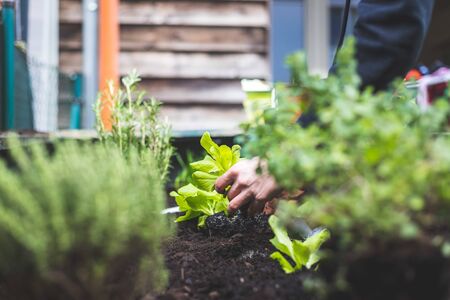Introduction to Sustainable Fertilisers in the UK
In recent years, British gardeners have become increasingly aware of their role in combating climate change and protecting the environment. As a nation known for its passion for gardening, from quaint cottage gardens to sprawling allotments, we’re now asking ourselves how our choices—right down to the fertilisers we use—impact the world around us. Sustainable fertilisers are gaining ground as an alternative to conventional products, promising not only to nourish our beloved plants but also to reduce harmful emissions and preserve soil health for future generations. But what exactly are sustainable fertilisers, and why do they matter so much here in the UK? In essence, these are plant feeds produced with minimal environmental impact, often made from renewable or recycled materials, designed to release nutrients gradually without polluting our waterways or contributing excessively to greenhouse gas emissions. Given our temperate climate and unique biodiversity, choosing the right fertiliser can make a real difference—supporting both lush gardens and a greener Britain for years to come.
Traditional versus Sustainable Fertilisers
When it comes to nourishing our British gardens, the choice between traditional and sustainable fertilisers can make all the difference—not just for our roses and runner beans, but for the environment as well. For generations, gardeners across the UK have relied on conventional fertilisers, often synthetic and readily available in garden centres from Kent to Cumbria. Products like Growmore or standard granular feeds have long been a staple in sheds up and down the country. However, these conventional options often contain high levels of nitrogen, phosphorus, and potassium derived from non-renewable sources, contributing to greenhouse gas emissions during both production and use.
In contrast, sustainable or eco-friendly fertilisers are gaining ground amongst those keen to reduce their carbon footprint and leave the soil richer for future generations. These alternatives tend to be made from organic materials—think well-rotted horse manure from local stables, seaweed-based feeds so popular along our coastal communities, or homemade compost brewed in the back garden compost heap. Many sustainable fertilisers also come with organic certification, ensuring they’re produced with minimal environmental impact.
Comparing Conventional and Sustainable Fertilisers
| Type | Common Examples in UK | Main Ingredients | Environmental Impact |
|---|---|---|---|
| Conventional | Growmore, Blood Fish & Bone, Chemically granulated feeds | Synthetic NPK (Nitrogen-Phosphorus-Potassium), chemical additives | Higher emissions during production; runoff can pollute waterways |
| Sustainable | Compost, Seaweed extract, Well-rotted manure, Bone meal (organic certified) | Organic matter, recycled plant/animal material | Lower emissions; improves soil health; supports biodiversity |
The British Perspective on Fertilising Practices
Many British gardeners still favour tradition—after all, there’s comfort in doing things as one’s parents or grandparents did. However, the shift towards eco-friendly choices is gathering pace. Allotment societies now swap tips about making liquid nettle feed or sourcing peat-free composts. Even established brands are introducing greener alternatives. The benefits are more than environmental; sustainable fertilisers often improve soil structure and resilience—a boon during those unpredictable British summers where we swing from droughts to deluges.
![]()
3. The Environmental Impact: Lowering Garden Emissions
When we talk about tending to our beloved British gardens, its easy to overlook how our choices can affect the environment beyond our own back fence. Many of us have grown up with the familiar whiff of chemical fertilisers, but times are changing, and so must our approach. Selecting sustainable fertilisers is not just a modern fad—its a practical step towards lowering the carbon footprint right here at home.
The Hidden Costs of Conventional Fertilisers
Traditional fertilisers, especially those heavy in synthetic chemicals, are notorious for their hefty environmental price tag. Theyre often produced using fossil fuels and can release greenhouse gases during both production and application. In the UK, where weather can be unpredictable, excess nutrients from these products easily wash into our rivers and streams, causing pollution and harming local wildlife—a concern that’s been voiced by many an old gardener down the allotment.
Sustainable Choices for Greener Gardens
Opting for organic or sustainably sourced fertilisers makes a real difference. These alternatives typically rely on natural processes—think composted manure from British farms or plant-based feeds—which not only reduce harmful emissions but also improve soil health over time. By using locally-sourced options where possible, we also cut down on transportation emissions, keeping things closer to home and supporting British agriculture in the process.
Practical Steps for Everyday Gardeners
If youre keen to tread lightly, start by reading labels and asking your local garden centre about sustainable options. Small changes like switching to peat-free composts or making your own leaf mould can add up. Remember what my father used to say: “Take care of your patch of earth, and itll take care of you.” By being mindful about what goes into our gardens, we help ensure theyre places of beauty for generations yet to come.
4. Sourcing Local and Organic Fertilisers
One of the most practical ways to reduce emissions in your British garden is by opting for local and organic fertilisers. Not only does this cut down on transport-related carbon emissions, but it also supports regional economies and encourages sustainable farming practices close to home.
Guidance for Finding Local Suppliers
Start your search at nearby garden centres, farm shops, or community allotment groups—many now offer organic compost, well-rotted manure, or locally produced green waste fertilisers. Websites like Garden Organic or RHS Find a Supplier are also invaluable resources. Don’t hesitate to have a chat with fellow gardeners or ask at your local farmers’ market; you’d be surprised how often personal recommendations lead to the best finds.
Understanding Labels: What to Look For
British fertiliser labels can sometimes be a puzzle, so here’s what you need to know:
| Label Term | What It Means | Why It Matters |
|---|---|---|
| Organic Certified | Meets UK/EU organic standards (e.g., Soil Association logo) | No synthetic chemicals; environmentally friendly |
| Peat-Free | Contains no peat moss extracted from bogs | Protects precious UK peatlands and reduces emissions |
| Locally Produced | Sourced and processed within your region or county | Lowers transport footprint; supports local jobs |
| Green Waste Compost | Made from recycled garden/food waste via council schemes | Circular economy; diverts waste from landfill |
Supporting Regional, Organic Farming Initiatives
If you’re keen to go the extra mile, consider joining a community composting scheme or subscribing to an organic box delivery that includes soil amendments from nearby farms. Many regional initiatives—like LEAF (Linking Environment And Farming) or Sustain’s Good Food projects—welcome volunteers or supporters. By getting involved, you not only enrich your own plot but help build a more resilient and eco-friendly food system for everyone.
A Quick Checklist for British Gardeners:
- Buy from independent nurseries and farm shops when possible.
- Look for the Soil Association or Organic Farmers & Growers logo on bags.
- Avoid products containing peat or artificial additives.
- Ask about the origin of animal manures—ideally, they should come from local, high-welfare farms.
- Engage with community composting schemes in your area.
Remember: Every small choice adds up. By sourcing wisely and supporting local, you’re doing your bit for both your garden and the planet.
5. Practical Tips for the Everyday Gardener
If you’ve been pottering about in your back garden for years, you’ll know there’s no one-size-fits-all approach—especially with our famously unpredictable British weather. But making the switch to sustainable fertilisers doesn’t have to be a faff. Here are some tried-and-true tips that fit seamlessly into daily routines, whether you’re nurturing roses along a classic cottage path or tending to tomatoes in an urban allotment.
Start with What You Have
Before dashing off to buy anything new, take stock of what’s already at hand. Old leaves, grass clippings, and even tea bags (provided they’re plastic-free) can be composted. A good home compost heap not only cuts down on kitchen waste but also produces rich, homemade fertiliser perfectly suited to the needs of British soils.
Read the Weather—And Work With It
It’s no secret that our gardens see everything from relentless drizzle to blazing sunshine—sometimes in a single afternoon! Apply natural fertilisers just before rain is forecast; this helps nutrients soak deep into the soil rather than washing away. If it’s been dry for ages, water first so your fertiliser isn’t wasted on parched ground.
Choose Local and Organic Where Possible
Seek out fertilisers produced close to home—like seaweed-based products from the British coast or well-rotted manure from nearby farms. Not only does this support local businesses, but it also keeps transport emissions down. Always check labels for certifications such as Soil Association Organic Standard if you want extra peace of mind.
Mind Your Garden Layout
Every patch is different. Raised beds and containers tend to dry out faster, especially during those unexpected summer heatwaves. Mulch around plants with compost or leaf mould to lock in moisture and release nutrients slowly—a trick my gran swore by during her long gardening days in Kent.
Keep Fertilising Simple and Regular
No need to overdo it—little and often works wonders. Use a watering can with a rose attachment for liquid feeds, ensuring even coverage without compacting the soil. And always avoid fertilising just before frost is due; cold snaps can prevent nutrients from breaking down properly.
Share Knowledge Over the Fence
The best advice often comes from a neighbour who’s been coaxing dahlias into bloom since the 70s. Swap surplus compost, share tips about eco-friendly suppliers, or organise a seedling exchange at your local community centre. Together, we can make sustainable gardening second nature across Britain’s green and pleasant land.
6. Success Stories from British Allotments and Gardens
Across the UK, gardeners from all walks of life have taken it upon themselves to source sustainable fertilisers, with heartening results that not only nurture their plants but also foster a sense of community and environmental responsibility. Take, for example, Mrs. Hughes in Yorkshire, who swapped out synthetic feeds for homemade compost and locally sourced manure at her village allotment. She beams with pride when she tells us, “My tomatoes have never tasted sweeter, and I know I’m doing my bit for the planet.” Her neighbours soon followed suit, sharing tips and swapping bags of leaf mould and spent hops from the local brewery—turning sustainability into a shared adventure.
Further south in Kent, Mr. Patel converted his small back garden into a veritable haven using seaweed fertiliser collected from permitted stretches along the coast. He reports stronger root systems in his beans and noticeably fewer pests, attributing this success to both the natural nutrients and the way seaweed enriches the soil’s structure. “It’s traditional wisdom,” he says, “passed down from my granddad who gardened by the Thames.” These stories echo around Britain: on London rooftop gardens using worm castings from urban composters, or in Scottish allotments where well-rotted sheep dung—sourced directly from friendly local farmers—brings bumper crops of tatties year after year.
Many gardeners mention a greater connection to the land and their communities. Mrs. Evans from Cardiff recalls how switching to green manures encouraged her children to get involved: “They love digging in the clover and watching our little patch spring back to life each season.” This hands-on experience not only reduces emissions but also sows seeds of environmental stewardship in future generations.
Of course, challenges remain—such as finding reliable sources of sustainable fertiliser or convincing sceptical friends—but these are often overcome through word-of-mouth advice at allotment meetings or online forums dedicated to British gardening traditions. As more people share their successes and setbacks alike, a growing network of passionate individuals is ensuring that sustainable fertilising becomes as much a part of British gardening lore as wellies and tea breaks.
These anecdotes prove that with a bit of old-fashioned ingenuity and community spirit, reducing emissions through better fertiliser choices is entirely within reach for British gardeners. The journey may start with a single compost heap or a handful of seaweed, but it quickly grows into something much bigger—a nationwide movement rooted in respect for nature and neighbour alike.


